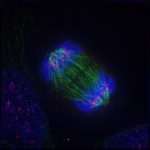Table of Contents
Nucleolus Definition
noun
plural: nucleoli
nu·cle·o·lus, njuːˈkliːələs
(cell biology) The round granular structure within the nucleus of a cell, composed of proteins, DNA, and RNA, and functions primarily for the creation of ribosomes
Overview
In eukaryotic cell, the nucleus is the organelle responsible for maintaining the integrity of DNA and for controlling cellular activities such as metabolism, growth, and reproduction by regulating gene expression. It is a double-membraned organelle containing nuclear structures, e.g. chromatin and nuclear bodies. A nuclear body refers to any of the prominent non-membraned structures in the nucleus of the eukaryotic cell.
Nuclear bodies are prominent structures of non-chromatinic fibrillary material and mostly proteinaceous. Nucleolus, the round granular structure within the nucleus of a cell, composed of proteins, DNA, and RNA, and functions primarily for the creation of ribosomes, is one of the most well-known nuclear structures. Other examples of nuclear bodies are Cajal bodies and gems (Gemini of Cajal bodies), polymorphic interphase karyosomal association (PIKA) domains, promyelocytic leukaemia protein (PML) bodies, splicing speckles, paraspeckles, perichromatin fibrils, and clastosomes.
Characteristics
In some references, nucleolus is regarded as an organelle, particularly a non-membrane-bound organelle (as opposed to the membrane-bound organelles). Others do not consider nucleolus as an organelle because of its lack of a lipid bilayer membrane. Rather, it is considered as one of the nuclear bodies found within the nucleus.
Nucleolus is a round and granular structure located inside the nucleus. It is the most prominent subnuclear structure in the nucleus. It is composed of proteins, DNA, and RNA. In higher eukaryotes, three major components are (1) the fibrillar center (FC), the dense fibrillar component (DFC), and the granular component (GC).1 The FC is involved in the transcription of the rDNA. The DFC contains fibrillarin protein associated with rRNA processing. The GC contains the protein nucleophosmin involved in ribosome biogenesis. In plants, another structure is recognizable — a clear area in the center of the nucleolus called the nucleolar vacuole.2 The granular component of nucleolus refers to the area of nucleolus that appears granular as opposed to the pale staining and fibrillar areas in the electron microscope .The granular appearance is due to the presence of 15nm-diameter maturing ribosomes. The nucleolus contains nucleophosmin, which is a protein responsible for the transport of fluid between nucleus and cytoplasm involved in various cellular functions including protein formation, DNA replication and cell cycle. Another protein present in the nucleolus is the nucleolar protein 3, a protein involved inRNA splicing and inhibits apoptosis to down regulate the enzyme activity. The nucleolus organizer region (NOR) is a region in the chromosome around which the nucleolus forms. NORs are located on the satellite stalks of the acrocentric chromosomes.
Common biological reactions
Ribosome biogenesis refers to the biosynthesis of ribosomes. In eukaryotes, the sites of ribosome formation are the cytoplasm and the nucleus. The ribosome of eukaryotes is 80S as opposed to the ribosome of prokaryotes, which is 70S. The 80S ribosome is comprised of a large subunit (60S) and a small subunit (40S). Each of these subunits is comprised of ribosomal protein and rRNA(s). The ribosomal proteins are synthesized in the same manner as other proteins are produced, i.e. first by transcription within the nucleus and then moved into the cytoplasm for translation and maturation. Mature ribosomal proteins are moved back into the nucleus, particularly in the nucleolus for ribosomal subunit assemblies, i.e. 60S or 40S assembly. As for the rRNA components of the 60S or 40S, they are produced in the nucleus. In mammals, the rRNAs 18S, 28S, and 5.8S are transcribed in the nucleolus organizer region into a single unit pre-rRNA (referred to specifically as 45S pre-RNA) by the catalytic action of RNA polymerase I. The result is a large pre-rRNA made up of 18S, 28S, and 5.8S, which after processing would be released individually. As for the 5S rRNA, the genes encoding for it are transcribed into pre-5S rRNA by the RNA polymerase III. However, the pre-5S rRNA transcript is produced in the nucleoplasm, outside the nucleolus. Nevertheless, it finds its way to the nucleolus for the assembly. To form the large subunit (i.e. 60S) of the ribosomal complex, 5S rRNA combines with 28S and 5.8S rRNA. 18S, in turn, forms the small subunit (i.e. 40S) by combining with the ribosomal proteins. These subunits would then be moved from the nucleolus into the cytoplasm for the assembly of complete and functional 80S ribosome.
Biological functions
The nucleolus is involved with ribosomal RNA synthesis and the formation of ribosomes in eukaryotes. It is also functions in the assembly of signal recognition particles and in the cell’s stress response.
Etymology
- Latin, diminutive of nucleus, meaning “kernel”
Related terms
- Granular component of nucleolus
- nucleolar
- nucleolar organizing region
- Nucleolar organizer region banding
- Nucleolar protein 3
See also
- nucleus
- organelle
- cell
- nuclear body
Reference
- Koberna, K., Malínský, J., Pliss, A., Mašata, M., Večeřová, J., Fialová, M., Bednár, J., and Raška, I. (2002). “Ribosomal genes in focus: new transcripts label the dense fibrillar components and form clusters indicative of “Christmas trees” in situ”. J. Cell Biol. 157 (5): 743–8.
- Beven, A. F., Lee, R., Razaz, M., Leader, D. J., Brown, J. W., and Shaw, P. J. (1996). “The organization of ribosomal RNA processing correlates with the distribution of nucleolar snRNAs”. J. Cell. Sci. 109 (6): 1241–51.
© Biology Online. Content provided and moderated by Biology Online Editors





